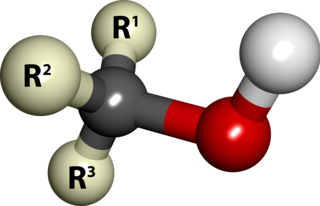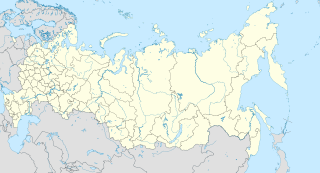
In chemistry, an alcohol is any organic compound in which the hydroxyl functional group (–OH) is bound to a carbon. The term alcohol originally referred to the primary alcohol ethanol, which is used as a drug and is the main alcohol present in alcoholic beverages. An important class of alcohols, of which methanol and ethanol are the simplest members, includes all compounds for which the general formula is CnH2n+1OH. It is these simple monoalcohols that are the subject of this article.

Denatured alcohol, also called methylated spirit or denatured rectified spirit, is ethanol that has additives to make it poisonous, bad-tasting, foul-smelling, or nauseating to discourage recreational consumption. It is sometimes dyed so that it can be identified visually. Pyridine, methanol, or both can be added to make denatured alcohol poisonous, and denatonium can be added to make it bitter.
Biodiesel production is the process of producing the biofuel, biodiesel, through the chemical reactions of transesterification and esterification. This involves vegetable or animal fats and oils being reacted with short-chain alcohols. The alcohols used should be of low molecular weight. Ethanol is the most used because of its low cost, however, greater conversions into biodiesel can be reached using methanol. Although the transesterification reaction can be catalyzed by either acids or bases, the base-catalyzed reaction is more common. This path has lower reaction times and catalyst cost than those acid catalysis. However, alkaline catalysis has the disadvantage of high sensitivity to both water and free fatty acids present in the oils.

tert-Butyl alcohol (TBA), also called tert-butanol or t-butanol, is the simplest tertiary alcohol, with a formula of (CH3)3COH (sometimes represented as t-BuOH). It is one of the four isomers of butanol. tert-Butyl alcohol is a colorless solid, which melts near room temperature and has a camphor-like odor. It is miscible with water, ethanol and diethyl ether.
Karnataka liquor deaths are deaths in Karnataka state in India in 1981 by consuming illegal liquor. In July 1981 about 308 people died in Bangalore by illicit liquor. Adulteration of cheap liquor by methyl alcohol resulted in deaths.
The Gujarat alcohol poisonings occurred in July 2009 in Gujarat, resulting in the death of 136 people from consumption of bootleg liquor.

Alcohol prohibition in India is in force in the states of Bihar, Gujarat, Mizoram and Nagaland as well as in the Union Territory of Lakshadweep. All other Indian states and union territories permit the sale of alcohol.
The 2008 Karnataka-Tamil Nadu alcohol poisonings was an incident in the southern Indian states of Karnataka and Tamil Nadu in May 2008 in which 180 people reportedly died after consuming illicit liquor. This incident is considered to be the worst methanol poisonings in the country since at least 2000.
In June 2015, at least 102 people died after drinking contaminated alcohol in the Laxmi Nagar slum in Malad, located in Mumbai, India. Another 45 people were hospitalised as a result of the incident. The incident has been described as the worst of its kind in over a decade.

The Bombay Prohibition Act, 2009 is an Act of Gujarat Legislative Assembly which prohibits manufacture, selling, buying or distributing of Laththa.
The Bihar alcohol poisonings killed 16 people on 16 August 2016 in Gopalganj town of Bihar, India. The victims had consumed hooch and complained of nausea and stomach ache.
The 2011 Bengal alcohol poisonings killed 167 people in December 2011 in the eastern Indian state of West Bengal after consumption of spurious liquor mixed with methanol.
The Azamgarh alcohol poisonings resulted in the deaths of 39 people in Azamgarh city of Uttar Pradesh state in India, In October 2013, due to consumption of moonshine mixed with the methyl alcohol (methanol). This is one of the worst alcohol poisonings in the state. Locals contested the death toll claiming 40 people had died in the incident.
The 2015 Bengal alcohol poisonings led to the deaths by methanol poisoning of 15 people in the state of West Bengal in India.

In December 2016, 78 people died in a mass methanol poisoning in Irkutsk, one of the largest cities in Siberia, Russia. Precipitated by drinking counterfeit surrogate alcohol, the death toll led the Associated Press news agency to call it "unprecedented in its scale".
In February 2019, at least 168 people died after drinking toxic bootleg alcohol in Golaghat and Jorhat districts in Indian state of Assam. The incident occurred two weeks after 100 people died by drinking toxic alcohol in the northern states of Uttar Pradesh and Uttarakhand.





